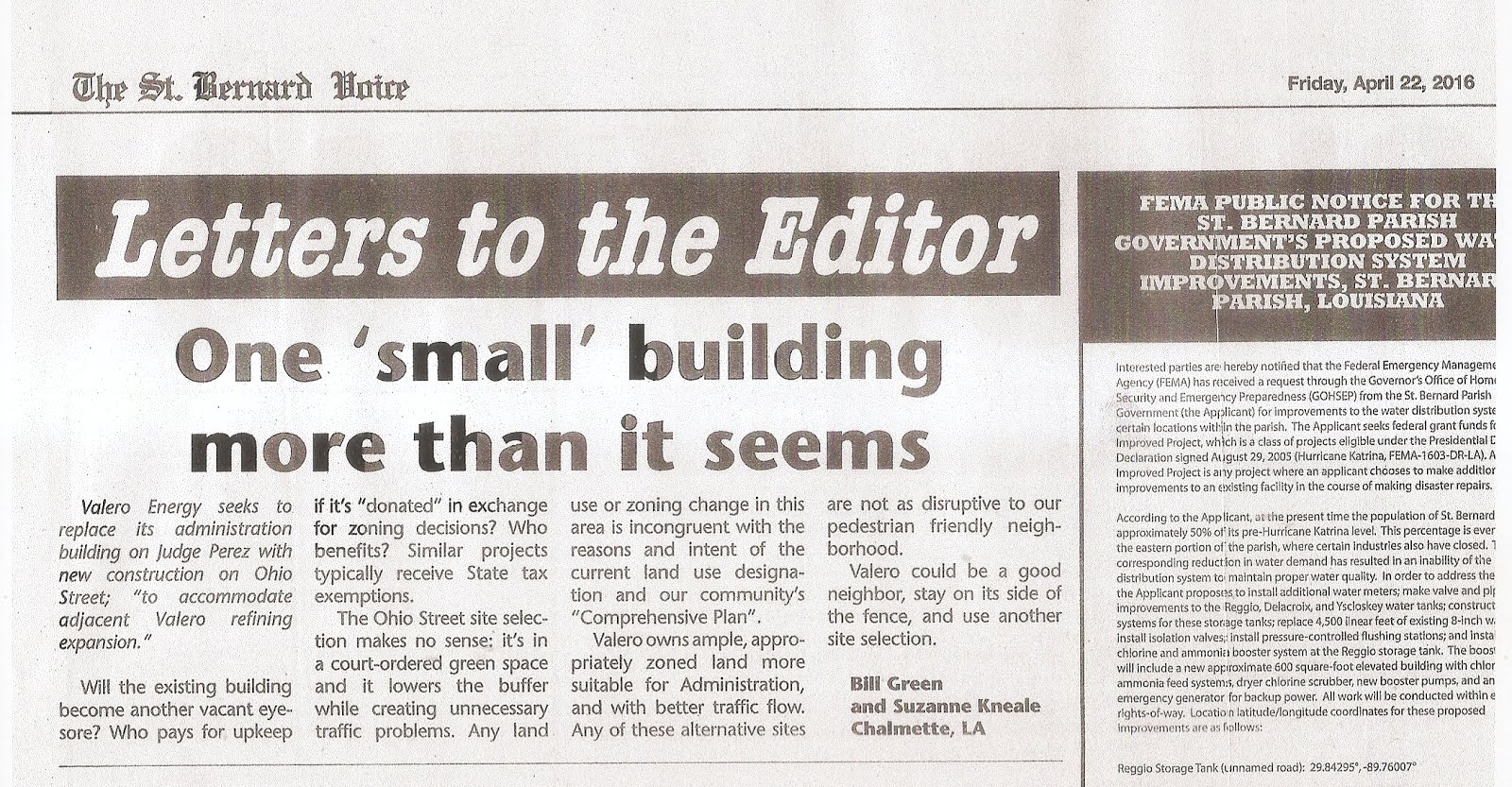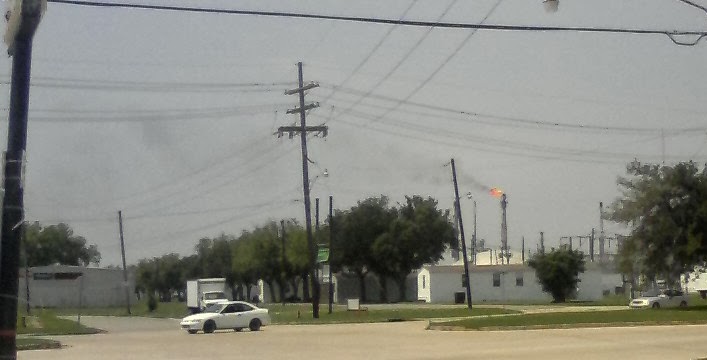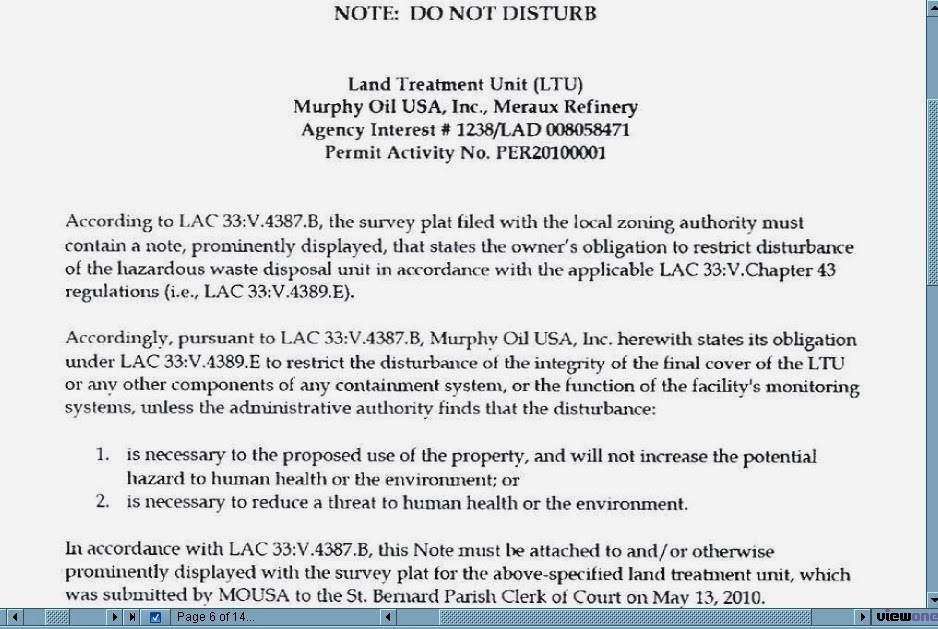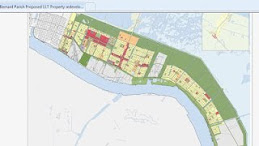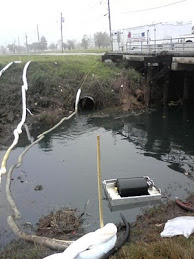Monday, February 11, 2013
flaring causes sulfur health violations
Flaring event from an upset at Valero Energy's Meraux refinery, yesterday. Sulfur dioxide concentrations violated health standards, as measured in the neighborhood at Valero's Ventura Drive ambient air monitor. St Bernard Parish is already non-attainment for sulfur dioxide; the air quality in St Bernard Parish fails to meet the sulfur health standards, based on an air monitor in Chalmette Vista. The increasing sulfur dioxide concentrations measured at the Ventura Drive monitor may further demonstrate the sulfur health issue throughout the community.
submitted by a concerned resident
clouds of pollution releases in yesterday's flaring event
residents reported intolerable odors throughout the neighborhood
the sulfur dioxide had entered homes
Failure to meet health standards for sulfur dioxide occurs when SO2 hourly average concentrations fail to remain below 75 parts per billion. Areas are considered non-attainment when the 3 year average of the annual 99th percentiles fail to remain below 75 ppb. St Bernard Parish's current 3 year average is 255 ppb (based on the Chalmette Vista monitor). At the Ventura Drive monitor, the highest reading in 2012 was 120 ppb. The second highest reading at Ventura Drive in 2012 was 48 ppb, and to date in 2013 the second highest reading is 138 ppb. It's entirely possible that IF the Valero Ventura Drive monitor measures SO2 concentrations at or above 40 ppb in 2014, the 3 year average based on that monitor could fail to be below 75 ppb.
The sulfur dioxide pollution problem is throughout the community and we all need to do our part to be part of the solution; our lives and our future depend on it.
.
Sunday, February 3, 2013
Ozone in St Bernard Parish, Louisiana
St Bernard Parish Air Quality
UNLESS ................................................
“Unless someone like you cares a whole awful lot,
Nothing is going to get better. It's not.”
― Dr. Seuss, The Lorax
Nothing is going to get better. It's not.”
― Dr. Seuss, The Lorax
Ozone is formed when nitrates of oxygen (NOx) and volatile organic compounds (VOCs) combine together in sunlight. One solution to high concentrations of ground level ozone is the use of fuel that contains less benzene and lower sulfur content. Some communities switch public transportation buses and school buses to bio diesel or natural gas or use ultra low sulfur content fuels in an attempt to reduce Ozone pollution.
Ozone Attainment Status
The Good News on Ozone levels in St Bernard is there seems to be enough lead time to address the Ozone issue before being designated or labeled non-attainment for Ozone. It's a violation of the Ozone standard when the 8-hour average of ground level ozone does not remain below the current standard of 75 parts per billion. (The old standard was an 8-hour average of 80 parts per billion). An area would be recommended for designation (or "labeled") non-attainment when the annual fourth-highest daily maximum 8-hour concentration of Ozone, averaged over 3 years, is 75 ppb or higher. http://www.epa.gov/air/criteria.html In St Bernard Parish, Ozone levels are sampled at the LDEQ "Meraux" site at Joe Davies Elementary School.
According to data on EPA's Air Data website, St Bernard Parish's current 3 year average for Ozone is around 73 ppb and we all need to do our part to keep it below 75 ppb. (Based on annual fourth highest daily maximum 8 hour concentration of Ozone for 2010 at 74 ppb , for 2011 at 76 ppb , for 2012 at 69ppb. { [(74+76+69) / 3 ] = 73 ppb} From http://www.epa.gov/airdata/ left hand column menu, select Monitor Values, select Ozone, select Louisiana, select year, scroll down to 8-hour averages.) LDEQ's "Meraux" site readings assessible here , under site data, select "Meraux".
.
So, now is the time for all of us to do our part to be part of the solution, to work with coalitions to reduce Ozone, and to protect what little is left of our good air quality. Part of success stories, like St Bernard's in the late 1990's and Baton Rouge's recent success to reduce Ozone, are coalitions that take "Early Action" to reduce pollution before its so bad. For Ozone, this would include even further reduction of NOx (nitrates of oxygen) and VOCs (volatile organic compounds such as benzene, ethylbenzene, toluene, xylene and others) at all nearby industries, and the use of "Clean Fuels" in buses, trucks and other vehicles, including barge and ship traffic on the Mississippi River.
Clean Fuels create dirty neighborhoods
Clean Fuels create dirty neighborhoods
But Ozone and Clean Fuel Projects are sort of a Catch 22 in communities where the Clean Fuel is manufactured. When EPA mandates lower benzene and sulfur content in Clean Fuels, the refining of crude oil into "Clean Fuels" results in more sulfur dioxide and VOCs, such as benzene, in the fenceline neighborhoods, unless the LDEQ requires more stringent pollution controls. It seems Clean Fuels Projects that began around the late 1990's, or early 2000, were "grandfathered in" and LDEQ didnot require the state-of-the-art pollution controls. The result: St Bernard Parish is now the poster child for sulfur dioxide pollution, with concentration levels three times higher than the one-hour sulfur health limit, the 2nd highest sulfur dioxide concentrations in the United States, second only to Hawaiin communities that seem to be around active volcanoes. The EPA is expected to make its official designation of St Bernard Parish as non-attainment for sulfur dioxide health standards.
Calcined petroleum coke (CPC) also contributes sulfur emissions. Louisiana is the largest CPC producing region in the world outside of China, with several Rain CII coke plants accounting for more than half of Louisiana’s CPC production. Rain CII's facility in Chalmette operates under a variance and has received several additional exemptions to bypass the pyroscrubber and vent emissions for upto 500 hours a year. Rain CII Chalmette recently applied for a "minor" modification to its Title V air permit to make the variance permanent and to increase the total of bypass or vent time to 836 hours. This "minor" application is separate from its December 2012 short-term variance for 336 hours that LDEQ pulled in January 2013 admist concerns of high sulfur levels in the adjacent neighborhood. As a "minor" modification, the Title V air permit is subject to less stringent pollution controls than "major" modifications. Minor modifications do not require pubic notice or a cost benefit analysis. St Bernard Parish Government has requested LDEQ conduct a public hearing on the "minor" modification at Rain CII. This will be a good opportunity for concerned people and government bodies, such as the HRQL, to submit pubic comment.
Labels:
air quality,
Clean Fuels,
LA,
LDEQ,
Meraux,
ozone,
St Bernard Parish,
Tier 3 Mandate
sulfur dioxide concentrations
St Bernard Parish Air Quality
UNLESS ................................................
“Unless someone like you cares a whole awful lot,
Nothing is going to get better. It's not.”
Nothing is going to get better. It's not.”
― Dr. Seuss, The Lorax
Sulfur Dioxide Status
The Louisiana Department of Environmental Quality recommended EPA designate St Bernard Parish air quality non-attainment for sulfur dioxide (SO2). EPA is expected to make its official designation on June 3, 2013. LDEQ must submit a State Implementation Plan (SIP) by mid-2014; the SIP must demonstrate the area will reach attainment by 2017. Ambient air monitors display hourly averages for sulfur dioxide. It is a health violation when the one-hour average is 75 parts per billion (ppb) SO2 or higher. An area is considered non-attainment when the 3 year average of the 99th percentile of hourly average readings is 75 ppb or higher. According to EPA's AirData website, St. Bernard's current SO2 3 year average of the 99th percentiles is 255 ppb (two hundred fifty-five) and it needs to be 75 ppb or lower. Clearly there is alot a work ahead to bring sulfur dioxide pollution levels down.
BUT that is not the whole picture. Complete perimeter monitoring and more stringent pollution controls are paramount to the goal of reducing sulfur dioxide emissions. The readings in the EPA data bank are samples or readings when the wind is just right to make a direct hit or "air strike" on the monitor. There is a real need for perimeter or fenceline monitoring. We should demand more air monitors, perhaps placing additional monitors back on Mehle Avenue and back in Algiers on the west bank. Maybe adding monitors on the east side of ExxonMobil's refinery, perhaps around Lloyds Ave, sort of in-line with the Chalmette Vista monitor that is on E Chalmette Circle, and another one on the east side of Valero Energy's refinery, but not as far east as the Meraux monitor at Joe Davies School.
As an example:
From the Chalmette High School monitor data 2007 - 2011, the maximum hourly readings for each year were 95, 116, 54, 80, and 85 ppb SO2. Although the SO2 standard back then was a 24-hour average of 140 ppb and an annual limit of 30 ppb, the 3 year average was 64 ppb, approaching the current one-hour average 75 ppb limit. (The three year average of the last three available annual 99th percentiles is 64 parts per billion).
From the Meraux monitor data 2008 - 2012, the maxmium hourly readings for each year were 161, 36, 29, 58, and 59 ppb SO2. There seems to be an upward trend in sulfur dioxide concentrations in Meraux. In 2009, Murphy Oil installed interm, temporary pollution controls while in settlement talks with Concerned Citizens. The resultant EPA consent decree requires the new owner, Valero Energy, install a Flare Gas Recovery System by 2017, operate an air monitor on Ventura Drive in Chalmette, reduce various pollution emissions, increase on-site monitoring, and provide for public forums. In the meantime, Murphy Oil installed a benzene saturation unit without state-of-the-art pollution controls, adding to both the sulfur concentrations and VOC emissions. There is pending citizen enforcement action on the benzene unit. Valero Energy recently received a "minor" modification permit to revamp and expand the hydrocracker unit to increase production without more stringent pollution controls; this will result in even more sulfur dioxide pollution. In 2013, the EPA will require "Tier 3" Mandate compliance for even lower sulfur content in gasoline products. Both Valero Energy and ExxonMobil refineries will have to modify their plants to comply. If those modifications do not require more stringent pollution controls, the result will be increased sufur dioxide and VOCs.
The Valero Energy Ventura Drive monitor is not part of the EPA databank, and does not provide maxium reading data, although that information is available in the public forums. Valero Energy's Ventura monitor has its own share of sulfur health violations.
So, the problem is all over, and not just in Chalmette Vista.
.
From the Chalmette High School monitor data 2007 - 2011, the maximum hourly readings for each year were 95, 116, 54, 80, and 85 ppb SO2. Although the SO2 standard back then was a 24-hour average of 140 ppb and an annual limit of 30 ppb, the 3 year average was 64 ppb, approaching the current one-hour average 75 ppb limit. (The three year average of the last three available annual 99th percentiles is 64 parts per billion).
From the Meraux monitor data 2008 - 2012, the maxmium hourly readings for each year were 161, 36, 29, 58, and 59 ppb SO2. There seems to be an upward trend in sulfur dioxide concentrations in Meraux. In 2009, Murphy Oil installed interm, temporary pollution controls while in settlement talks with Concerned Citizens. The resultant EPA consent decree requires the new owner, Valero Energy, install a Flare Gas Recovery System by 2017, operate an air monitor on Ventura Drive in Chalmette, reduce various pollution emissions, increase on-site monitoring, and provide for public forums. In the meantime, Murphy Oil installed a benzene saturation unit without state-of-the-art pollution controls, adding to both the sulfur concentrations and VOC emissions. There is pending citizen enforcement action on the benzene unit. Valero Energy recently received a "minor" modification permit to revamp and expand the hydrocracker unit to increase production without more stringent pollution controls; this will result in even more sulfur dioxide pollution. In 2013, the EPA will require "Tier 3" Mandate compliance for even lower sulfur content in gasoline products. Both Valero Energy and ExxonMobil refineries will have to modify their plants to comply. If those modifications do not require more stringent pollution controls, the result will be increased sufur dioxide and VOCs.
The Valero Energy Ventura Drive monitor is not part of the EPA databank, and does not provide maxium reading data, although that information is available in the public forums. Valero Energy's Ventura monitor has its own share of sulfur health violations.
So, the problem is all over, and not just in Chalmette Vista.
.
From the Chalmette Vista site, 2007 - 2012 the air quality in that neighborhood had a total of 298 sulfur health violations, just in 2011 alone. Maximum hourly average readings for each year (2007 - 2012) were 477, 363, 373, 378, 375, and 242 SO2. Residents residing in Chalmette Vista are suffering the health effects and "unless someone like you cares a whole awful lot,Nothing is going to get better. It's not."
It is imperative our community take action to reduce sulfur dioxide concentrations. Perimeter monitoring and more stringent pollution controls are paramount to this goal.
Two of the oil refinery plants in St Bernard Parish operate under an EPA consent decree, both results of Citizen Enforcement Action by residents of St Bernard Parish. Any State Plan to reduce sulfur emissions in St Bernard Parish, will be reviewed by EPA. The other plant, the coke plant, operates on a variance for up to 500 hour bypass and recently applied to LDEQ to permanently increase that bypass to 836 hours. SBPG recently requested a public hearing on that permit (for Rain CII Carbon) and that will be an excellent opportunity for the HRQL an other government officials to submit public comments to the LDEQ.
Mehle Avenue, Arabi
2000 through 2005: Total
number of sulfur health violations 102
(Number of sulfur health
violations 15, 19, 7, 12, 34, and 15 for each respective year)
Annual 99th percentiles
sulfur dioxide 108, 141, 89, 93, and 161, and 177 ppb for each respective year.
Maximum hourly average readings 124, 191, 127, 138, 305, and 184 ppb for each respective year. The 3 year average based
on the last annual 99th percentiles would have been 143 ppb, well
over the current 75 ppb standard.
Algiers (Orleans Parish) "Entergy" site
2006 - 2007 : Total
number of sulfur health violations not counted by LDEQ because the Algiers site was part of a special monitoring project.
Maxium hourly average readings 154 ppb
and 306 ppb SO2. There is a clear need for monitoring in these west bank
communities.
Monitoring information
for the Algiers "Entergy" site on the westbank of the Mississippi River is
not included in the EPA databank. It is available in the LDEQ Air Quality 2009
Report (link below). This Algiers air monitor was located on property owned by Entergy Corporation. The "Entergy" site, along with the
Chalmette Vista and Chalmette High School air monitors were made possible
through the hard work and dedication of Mr. Ken Ford, founding president of St
Bernard Citizens for Environmental Quality, his neighbors, and the Louisiana Bucket Brigade. http://www.deq.louisiana.gov/portal/Portals/0/AirQualityAssessment/Analysis/Data/Chalmette-Report--Final,%202009.pdf
The EPA website does not
include data for the Chalmette High School and the Chalmette Vista sites for
2005 and 2006 due to insuffient number of readings because of down time from
Hurricane Katrina. More information on these sites is included in the LDEQ Air
Monitor Report 2009 at the link above.
Chalmette High School
2007 through 2011: Total
number of sulfur health violations 7 The EPA website does not include the 2005 and 2006 data due to insufficient number of readings because of down time in the aftermath of Hurricane Katrina. More information is included in the LDEQ 2009 Report .
( Number of sulfur
health violations 2, 3, 0, 1, and 1 for each respective year)
Annual 99th percentiles
sulfur dioxide 67, 73, 49, 57, and 85 ppb for each respective year. Maximum hourly average
readings 95, 116, 54, 80, and 85 ppb for each respective year. Maximum hourly average reading in 2006 was 95 ppb, per the LDEQ 2009 Report .
The 3 year average based on the last available annual 99th percentiles would have been 64 parts per billion. This was a sign that we were approaching non-attainment. If a monitor could be added east of ExxonMobil, but not as far as Chalmette High School, there would be a clearer indication of sulfur concentrations in that area.
Chalmette Vista E.
Chalmette Circle
2007 through 2012: Total
number of sulfur health violations 1,321 The EPA website does not include the 2005 and 2006 data due to insufficient number of readings because of down time in the aftermath of Hurricane Katrina. More information is included in the LDEQ 2009 Report .
( Number of sulfur
health violations 211, 233, 284, 206, 298, and 89 for each respective year)
Annual 99th percentiles
sulfur dioxide 349, 330, 314, 248, 300, and 217 ppb SO2 for each respective
year. Maximum hourly average readings 477, 363, 373, 378, 375, and 242 ppb SO2 for each respective
year. Maximum reading in 2006 was 271, per LDEQ 2009 Report
The current 3 year
average (of the 99th percentile) at Chalmette Vista is 255 ppb. We need to get the sulfur concentrations to
below 75 ppb to be in attainment for sulfur dioxide.
Meraux Mistrot Drive Joe
Davies School
2008 through 2012: Total
number of sulfur health violations 2
(Number of sulfur health
violations 2, 0, 0, 0, and 0 for each respective year)
Annual 99th percentiles
sulfur dioxide 49, 24, 24, 30, and 29 ppb SO2 for each respective year. Maximum
hourly average readings 161, 36, 29, 58, and 59 ppb SO2 for each respective year.
The current 3 year
average (of the 99th percentile) at Meraux is 28 ppb SO2, and trending upward, with increasing maximum hourly averages each year.
Subscribe to:
Posts (Atom)








